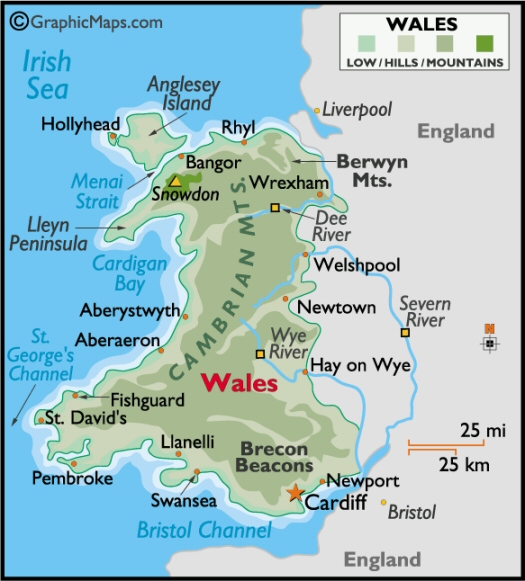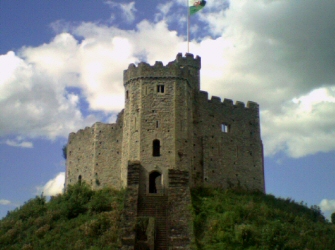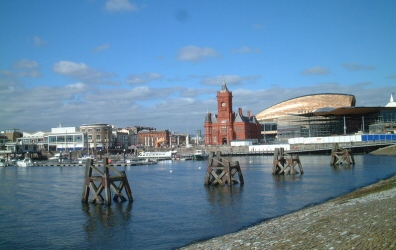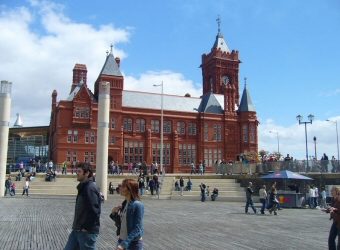1. Overview
3. Economy
4. Cardiff
 Hungary
Hungary

Around one-quarter of
The climate of Wales is Atlantic maritime,
that means
it never gets very hot or very cold. Even in the winter a raincoat and sweater
will usually cope with the worst that the weather has to offer. On the
whole,
...is a traditional list of seven geographic and cultural landmarks in Wales. The anonymous nursery rhyme listing the so-called seven wonders of Wales was probably written by an English visitor to North Wales sometime in the late 18th or early 19th century.
Pistyll Rhaeadr and Wrexham steeple,
Snowdon's mountain without its people,
Overton yew trees, St Winefride wells,
Llangollen bridge and Gresford bells.
Many would argue with his choice of so-called wonders. They are all found in the same general area, near Chester, handily situated on the English-Welsh border. They can be visited in a day or two:
1. Snowdon (Yr Wyddfa), the highest mountain in Wales: 1,085 m (3,560 ft)
2. Pistyll Rhaeadr, Wales's tallest waterfall, at 240 ft (75 m)
3. Gresford bells, the bells in the medieval church of All Saints at Gresford
4. Overton yew trees, ancient trees in the churchyard of St Mary's at Overton-on-Dee
5. Wrexham steeple, a 16th century tower of St. Giles Church in Wrexham
6. Llangollen bridge, built in 1347 over the River Dee. It is said to be the first stone bridge over the River Dee.
7. St Winefride's Well, a pilgrimage site at Holywell in Flintshire
It ranks as the smallest of the four economies of the United Kingdom in terms of GDP, though by some measurements it ranks above that of Northern Ireland. The modern Welsh economy is dominated by the service sector. Services contribute about two thirds of the GDP. The manufacturing sector contributes the other third, whilst Agriculture, forestry and fishing contribute 1-2%. About 80 % of the land in Wales is used for agricultural purposes. In general the raising of beef and dairy cattle and sheep is more valuable than crop cultivation. Forests cover about 12 % of the land, and government reforestation programs are gradually increasing the area. The fishing industry is concentrated along the Bristol Channel.
The Welsh economy, which was
traditionally based on coal and steel, experienced some major changes during
the 20th century.
...is
the capital (315,000; 2003
est.) of
England was overrun by Saxons and the Welsh coast was raided by Vikings (King Swein Forkbeard of Denmark left a permanent "I was here" at the city of Swein’s Eye – that’s Swansea).
Within 20 years of the Battle of Hastings, the Normans were marching on Wales. In 1091 a Norman baron, Robert FitzHamon began work on Cardiff Castle and a small settlement grew up around it. This was an English town in a hostile Welsh territory.
Owain Glyndwr razed Cardiff in 1404 during the Welsh War of Independence.
By the Elizabethan times Cardiff was a lawless, 'pirate-infested' port. In 1608 King James I granted a Royal Charter and by the 18th century it was a sleepy town of 1,500 people around the decaying castle.
The Industrial Revolution changed everything. In the 1790s the local gentry, the Butes, built the Glamorganshire Canal to join Cardiff with Merthyr Tydfil, followed by the first Cardiff dock in 1839.
Cardiff became the biggest coal-exporting port in the world. At its peak in 1913, more than 13 million tons of coal left here. Cardiff was granted city status in 1905 by Edward VII and in 1955 it was proclaimed capital of Wales.
Today, Cardiff is one of Europe’s most dynamic capital cities, constantly surprising visitors with its grace, space and 'cosmopolital buzz'.
Modern industries include retailing, services,
engineering, oil and gasoline distribution, and food processing. Studios of the
British Broadcasting Corp. are located in
From the top left corner:
Norman Keep; The Bay; The Wales Millenium Centre;
The Old Pier Head Building (home of The Welsh Assembly until 2006) in Cardiff bay




|
yew tree |
tiszafa |
|
pilgrimage site |
zarándokhely |
sources:
National Statistics, UK 2002, The Official Yearbook of Great Britain and Northern Ireland
Microsoft Encarta
1. Fractions extracted from from The Official Yearbook of GB and NI © Crown Copyright 2001, under PSI licence
2. 3rd, 4th and 5th photos of Seven Wonders of Wales © BBC Cymru Wales 2006
3. About Cardiff © Cardiff City Council 2006